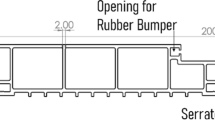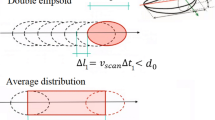Abstract
In hot die forging processes, the selection of an ideal preform is of great importance with respect to cavity filling and mechanical load. The common procedure in order to define an adequate preform is the usage of Finite-Element-Analysis (FEA), usually as an iterative process in which various preforms are tested with regard to their suitability. An approach that aims at reducing the number of trials by proposing a first estimation of a suitable preform is presented in this paper. It is conjectured that the material flow paths and resistance can be described by the cavity shape using the Medial Axis Transformation. Based on this, a local inverse material flow for time discrete steps is calculated. The result is a first estimation of an adequate preform shape within a few minutes as an input for further FEA. FE-based parametric design optimization procedure is then presented and compared to the inverse approach, which is identified as a useful complement for the forward simulation technique.








Similar content being viewed by others
Notes
Note, that it is in general not a 2-manifold, since it can have branches and fin-like structures.
All computations were carried out on four Intel Xeon CPUs with 2.66 GHz and 8 GB RAM.
References
Yang C, Ngaile G (2010) Preform design for forging and extrusion processes based on geometrical resemblance. Proc Inst Mech Eng Part B J Eng Manuf 224(9):1409–1423
Chang CC, Bramley AN (2000) Forging preform design using a reverse simulation approach with the upper bound finite element procedure. Proc Inst Mech Eng Part C J Mech Eng Sci 214(1):127–136
Wienströer M (2004) Prozesssimulation der Stadienfolge beim Schmieden mittels Rückwärtssimulation. Ph.D. thesis, Universität Hannover
Behrens BA, Wienströer M, Conrads H, Gue J (2006) Design integrated process modelling of forging sequences via backward simulation. Prod Eng Res Dev 13(2):157–160
Blum H (1967) A transformation for extracting new descriptors of shape. In: Wathen-Dunn W (ed) Proc. models for the perception of speech and visual form. MIT Press, Cambridge, pp 362–380
Wolter FE (1992) Cut locus and medial axis in global shape interrogation and representation. MIT Design Lab, Report 92-2, US National Sea Grant Library
Attali D, Boissonnat JD, Edelsbrunner H (2004) Stability and computation of medial axes: a state of the art report. In: T Möller BH, Russell B (eds) Mathematical foundations of scientific visualization, computer graphics, and massive data exploration. Springer, New York
Wolter FE, Friese KI (2000) Local and global geometric methods for analysis interrogation, reconstruction, modification and design of shape. In: Proceedings of computer graphics international 2000. Invited paper., pp 137–151
Culver T (2000) Computing the Medial Axis of a Polyhedron Reliably and Efficiently. Ph.D. thesis, Department of Computer Science, University of North Carolina, Chapel Hill
Giblin PJ, Kimia BB (2003) On the local form and transitions of symmetry sets, medial axes, and shocks. Int J Comput Vis 54(1/2/3):143–157
Okabe A, Boots B, Sugihara K, Chiu SN (2009) Spatial tessellations: concepts and applications of Voronoi diagrams. Wiley, New York
Turkiyyah GM, Storti DW, Ganter M, Chen H, Vimawala M (1997) An accelerated triangulation method for computing the skeletons of free-form solid models. Comput Aided Des 29(1):5–19
Rivara MC (2009) Lepp-bisection algorithms, applications and mathematical properties. Appl Numer Math 59(9):2218–2235
Dijkstra EW (1959) A note on two problems in connexion with graphs. Numerische Mathematik 1(1):269–271
Stander N, Roux W, Goel T, Eggleston T, Craig K (2012) LS-OPT users manual—A Design Optimization and Probabilistic Analysis Tool for the Engineering Analyst, v4.2. Livermore software technology corporation
Jonker PP (2000) Morphological operations on 3D and 4D images: from shape primitive detection to skeletonization. In: Borgefors G, Nystrm I, Baja GSd (eds) Discrete geometry for computer imagery. Springer Berlin Heidelberg, no. 1953 in lecture notes in computer science, pp 371–391
Acknowledgments
The authors thank the German Research Foundation (DFG) for the financial support of the research project "Schnelle inverse Materialflusssimulation für die Massivumformung mittels der dreidimensionalen Mediale-Achse-Transformation” (project numbers BE 1691/110-1 and WO 954/7-1).
Author information
Authors and Affiliations
Corresponding authors
Rights and permissions
About this article
Cite this article
Santangelo, A., Blanke, P., Hadifi, T. et al. Fast 3D inverse simulation of hot forging processes via Medial Axis Transformation: an approach for preform estimation in hot die forging. Prod. Eng. Res. Devel. 7, 409–416 (2013). https://doi.org/10.1007/s11740-013-0461-7
Received:
Accepted:
Published:
Issue Date:
DOI: https://doi.org/10.1007/s11740-013-0461-7




